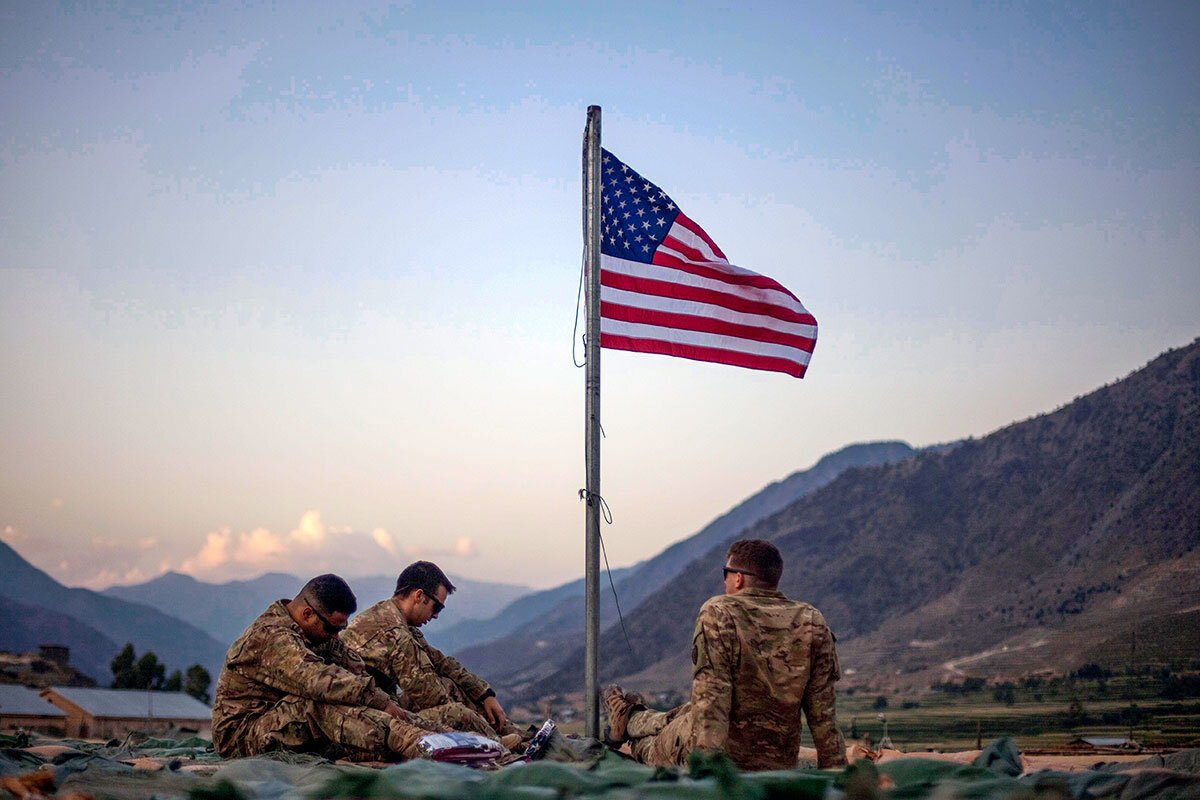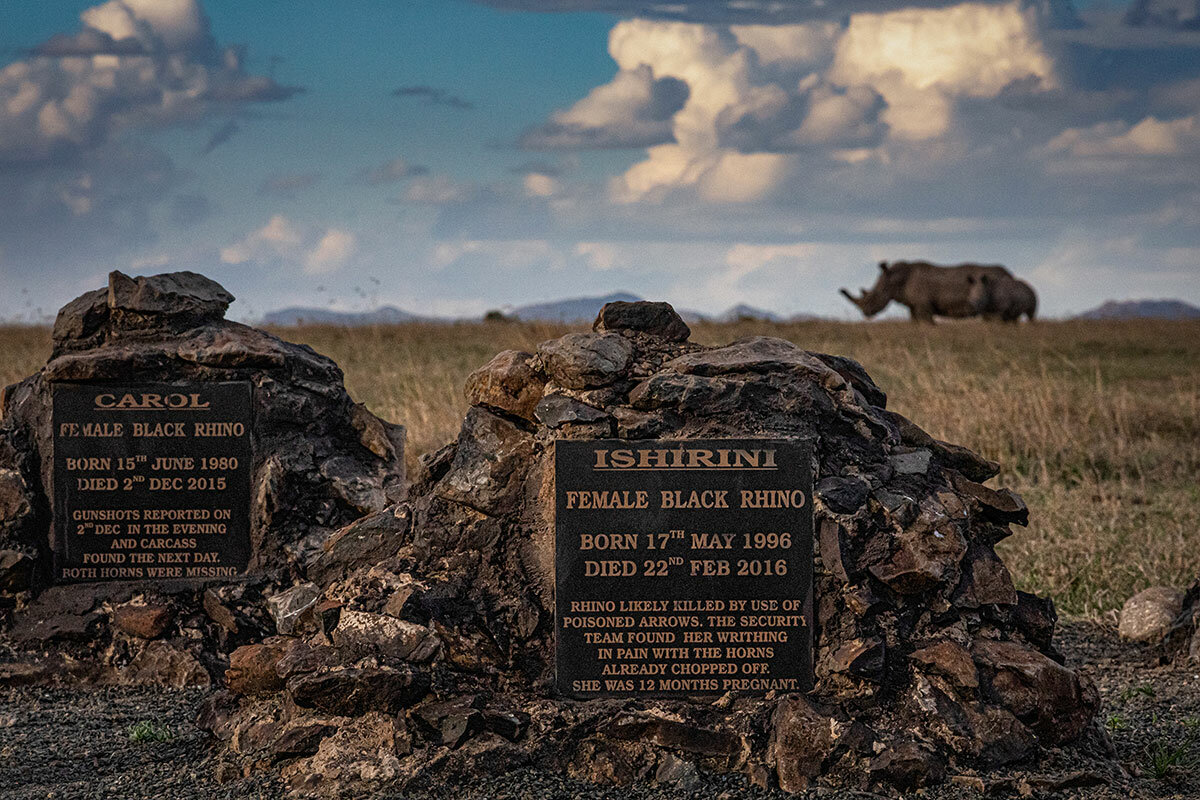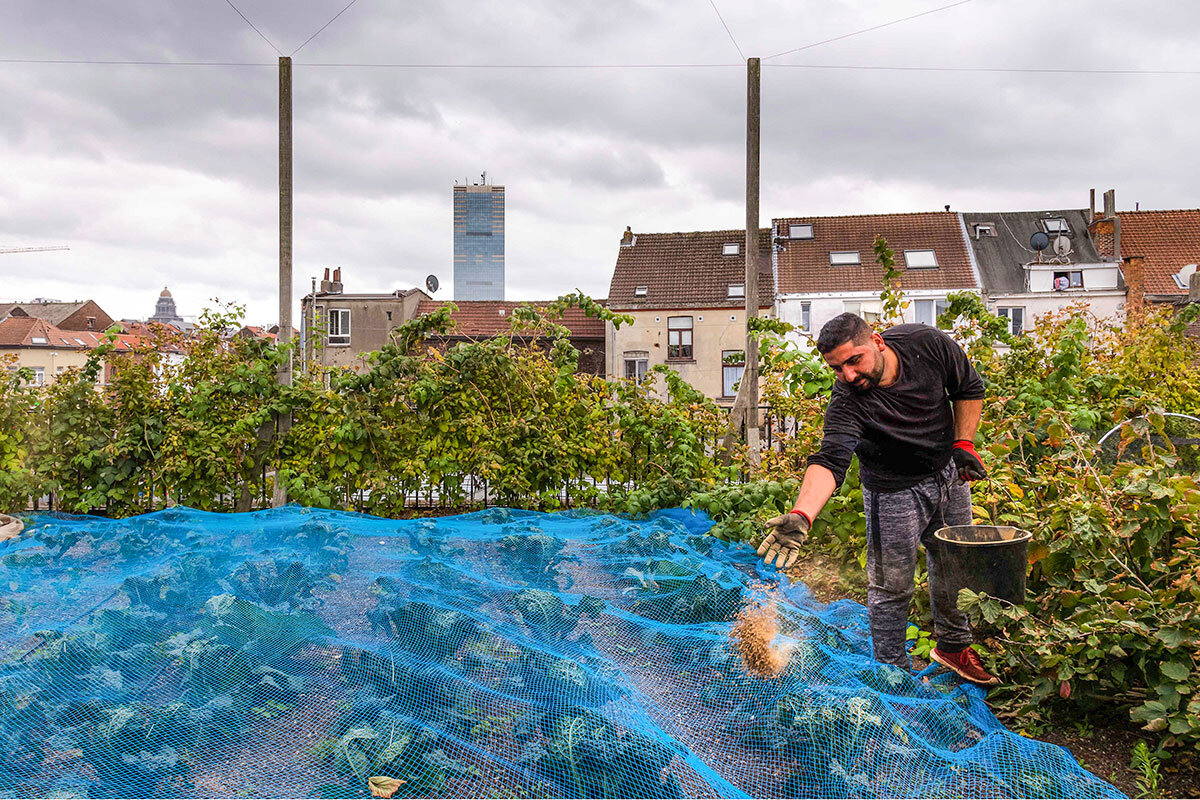- Quick Read
- Deep Read ( 6 Min. )

Why is Christian Science in our name?
Our name is about honesty. The Monitor is owned by The Christian Science Church, and we’ve always been transparent about that.
The Church publishes the Monitor because it sees good journalism as vital to progress in the world. Since 1908, we’ve aimed “to injure no man, but to bless all mankind,” as our founder, Mary Baker Eddy, put it.
Here, you’ll find award-winning journalism not driven by commercial influences – a news organization that takes seriously its mission to uplift the world by seeking solutions and finding reasons for credible hope.
Explore values journalism About usIn Today’s Issue
- After Afghanistan, what kind of wars does Pentagon want to fight?
- Rural New Mexicans meet drought with culture of water sharing
- Russian Arctic is losing people. Will free land bring them back?
- A risk that worked: Talking about race head-on with neighbors
- There are only two northern white rhinos left. Can the species be saved?
Monitor Daily Podcast
- Follow us:
- Apple Podcasts
- Spotify
- RSS Feed
- Download
TODAY’S INTRO
Can the wisdom of crowds get us closer to online truth?
Misinformation does more than arm dinner-table combatants with dubious talking points. With social media reach it bolsters false narratives, sways political constituencies, and influences policymakers on issues from abortion to climate science to vaccines.
Algorithms boost stories. And algorithms are about engagement, not accuracy. A blaring declaration can outplay a nuanced exploration.
So much for the wisdom of crowds, right?
That’s where it gets interesting. A new paper in Science Advances maintains that “layperson ratings” of the objective truthfulness of news can be surprisingly accurate. Could they be scalable tools in fighting misinformation?
Assembled groups of lay readers studied were diverse, including in stated political leanings. Individuals made determinations independently.
The action was predictably chaotic, but “even if the ratings of individual laypeople are noisy and ineffective, aggregating their responses can lead to highly accurate crowd judgments,” reads the paper. At 22 members, groups began outperforming the work of professional fact-checking sites.
“Our sense of what is happening is people are ... asking themselves, ‘How well does this line up with everything else I know?’” David Rand, an MIT professor and lead researcher, tells Wired. “You don’t need all the people to know what’s up. By averaging the ratings, the noise cancels out and you get a much higher resolution signal.”
That doesn’t mean shoving professionals aside. In the researchers’ view it’s just one more way for social platforms to foster a hierarchy of the credible.
“You want to be assigning ... some score on this continuous slider of totally accurate to pants-on-fire false,” Professor Rand tells Wired. “What I would do if I [were] them is, the worse it is the more you demote it.”
Share this article
Link copied.

Help fund Monitor journalism for $11/ month
Already a subscriber? Login

Monitor journalism changes lives because we open that too-small box that most people think they live in. We believe news can and should expand a sense of identity and possibility beyond narrow conventional expectations.
Our work isn't possible without your support.
After Afghanistan, what kind of wars does Pentagon want to fight?
The outcome of the longest U.S. war underscores a distaste for counterinsurgencies. But the need to engage in those may recur – even as the need to manage big-power conflicts also grows.

As the last of the U.S. forces withdrew from Afghanistan and closed the books on the longest war in American history, the general consensus seems to be that politicians won’t be asking the Pentagon to do that again anytime soon.
Yet the Pentagon’s boots-on-the-ground experience in Afghanistan will nonetheless leave a lasting imprint on military doctrine in ways that will continue to shape its leaders. That’s even as their focus pivots to what many consider to be the Department of Defense comfort zone of “great power competition” in places like Asia.
“A whole part of the pivot to Asia and great power competition – there is a threat there, and I don’t want to minimize it – but the enthusiasm with which this administration and the previous administration has seized on that threat is also the desire to fight the kind of wars we want to fight,” says Frederick Kagan, an architect of the surge of U.S. forces into Iraq and senior fellow at the conservative American Enterprise Institute.
In the wake of Vietnam, and again with America’s inglorious exit from Afghanistan, counterinsurgency has undoubtedly become “completely unfashionable,” he says. “But it’s an American myth that says we always get to choose the wars we fight.”
After Afghanistan, what kind of wars does Pentagon want to fight?
As the last of the U.S. forces withdrew from Afghanistan and closed the books on the longest war in American history, the general consensus seemed to be that politicians won’t be asking the Pentagon to do that again anytime soon.
The “that” includes sending hundreds of thousands of troops, as was the case at the height of the invasions of Iraq and Afghanistan, to win hearts and minds in a counterinsurgency campaign. For 20 years, the U.S. military was enlisted in the laudable if unrealized goal of creating a representative democracy – or at least a tolerably functioning inclusive state.
Yet the Pentagon’s boots-on-the-ground experience in Afghanistan will nonetheless leave a lasting imprint on military doctrine in ways that will continue to shape its leaders. That’s even as their focus pivots to what many consider to be the Department of Defense comfort zone of “great power competition” in places like Asia.
“A whole part of the pivot to Asia and great power competition – there is a threat there, and I don’t want to minimize it – but the enthusiasm with which this administration and the previous administration has seized on that threat is also the desire to fight the kind of wars we want to fight,” says Frederick Kagan, an architect of the surge of U.S. forces into Iraq and senior fellow at the conservative American Enterprise Institute.
In the wake of Vietnam, and again with America’s inglorious exit from Afghanistan, counterinsurgency has undoubtedly become “completely unfashionable,” he says. “But it’s an American myth that says we always get to choose the wars we fight.”
The failures of Afghanistan will be scrutinized on Capitol Hill this week, with Defense Secretary Lloyd Austin and Gen. Mark Milley, chairman of the Joint Chiefs of Staff, testifying before Senate and House Armed Services lawmakers on Tuesday and Wednesday. And while the failures of nation-building that relies on military might seem apparent, there are still conventional conflicts where U.S. military power can excel. But the experiences in Afghanistan also offer lessons for U.S. enemies, too.
The wars the Pentagon wants to fight “are always rapid, high-intensity, and decisive,” says retired Lt. Col. John Nagl, who helped to write the Army’s counterinsurgency field manual and is now a visiting professor of national security at the U.S. Army War College in Carlisle, Pennsylvania. And, on that front, the American military remains unparalleled.
Yet for that very reason, military leaders who grew up on the battlegrounds of Iraq and Afghanistan are well aware that “the wars our smart enemies will choose will be slow, grinding, and indecisive, largely as a result of our conventional military successes,” he says. “They will be much more like Vietnam and the counterinsurgency phases of Iraq and Afghanistan than World War III with China.”
Leaders would ostensibly seem ready to put the counterinsurgency field manuals on a high shelf, not to be dusted off for quite some time, as they did post-Vietnam. However, “my overriding thought is that we may no longer be interested in counterinsurgency, but doesn’t mean that insurgencies are no longer interested in us,” Dr. Nagl adds.
For now, though, the Senate Armed Services Committee’s Future of Defense Task Force 2020 report warns that China represents “the most significant economic and national security threat to the United States over the next 20 to 30 years.” Because of its nuclear arsenal and ongoing efforts to undermine Western democratic governments, Russia “presents the most immediate threat.”
That means that defense budgets will be getting boosts in areas like long-range rockets and missile defense, as well as artificial intelligence and biotechnology. These “will have an outsized impact on national security” since “the potential of losing this race to China carries significant economic, political, and ethical risks” for the U.S., the task force report argues.
Even as its priorities pivot, however, Pentagon leaders will continue to face a range of global threats and responsibilities.
At a typical news conference earlier this month, for example, the press secretary fielded questions on reports of North Korea’s successful test of long-range cruise missiles; accountability for a drone strike meant for an Islamic State operative that accidentally killed civilians, including children; prospects for counterterrorism operations in Africa; response to a measles outbreak among Afghan evacuees; National Guard involvement in a demonstration in support of Jan. 6 Capitol Hill rioters; and concerns that Guinean Special Forces trained by U.S. Green Berets had launched a military coup against their government.

For threats that range from predictable to far-fetched, the Pentagon must have plans in place. That said, “We tend to have champagne strategies on beer budgets,” says retired Brig. Gen. Tom Cosentino, who previously served as the commandant for the National War College. “When it comes time to start making choices on where to put our resources, I think it’s inevitable coming out of Iraq and Afghanistan and dealing with a pretty aggressive Chinese competitor, we’re going to see a shift into much more high-tech and high-intensity conflict focus.”
Mr. Cosentino recalls his time in midcareer military classrooms. “I remember very well sitting in my intel officer’s advanced course in 1990 to 1991 and talking about low-intensity conflict, and putting it in the context of Latin America, El Salvador, the FARC [Revolutionary Armed Forces of Colombia guerrillas], and so on. It never really leaves the doctrine. It’s there – it’s just how much of an emphasis it gets, and how much training you put against it.
“If demands on the military are to fund rockets and missile defense to help with an island-chain deterrent strategy in the Pacific, then that’s where the money will go. And one of the bill payers could be that capacity to do counterinsurgency,” he adds. “I don’t think it gets lost, but follow the money.”
That said, since 9/11 the U.S. military has developed a “pretty good ability” and knowledge within its special operations forces to pivot from counterterrorism operations to the training operations that are often at the core of hearts-and-minds campaigns, Mr. Cosentino says.
And while politicians may shy away from counterinsurgency for a time, the awareness of the importance of winning over civilians in what’s known as “population-centric warfare” is likely to stay with military leadership.
It is certainly a lesson that Moscow has embraced as it has watched the U.S. efforts to win over the population in Afghanistan and elsewhere, Dr. Kagan says.
“Fascinatingly, the guys who really got this was the Russians.” He points to hybrid warfare campaigns that include targeting the U.S. population with social media barrages in its efforts to disrupt U.S. elections.
Such developments are at the heart of the “never agains” of Afghanistan, he adds. “We cannot repeat the post-Vietnam mistake of jettisoning everything we just learned about this conflict.” Though the number of troops with combat experience in Iraq and Afghanistan will inevitably wash some of the knowledge out of the ranks, “people will fight to retain it.”
In the upper echelons of military strategic thinking, many of the critical lessons of America’s post-9/11 wars are yet to be determined, but will make “perfect curriculum” for the National War College and other military institutions of higher knowledge, Mr. Cosentino says.
“We’re always trying – at least if we’re effective – to put things in an historical context, to open the aperture of our students to think more strategically about the intersection of hard and soft power, how that operates,” he adds, “and how you make the hard decisions.”

A deeper look
Rural New Mexicans meet drought with culture of water sharing
As drought and climate change pose new challenges to New Mexico’s water supply, we look at responsive efforts to expand a tradition of shared access to water, long a scarce communal resource.

- Quick Read
- Deep Read ( 7 Min. )
Acequia is the name for a kind of irrigation ditch that rural people rely on to water their farms or orchards in arid New Mexico. But it is also something more.
“An acequia is a community of people,” says Paula Garcia, executive director of the New Mexico Acequia Association. “You have your right to the water, but you also have your responsibilities to the community.”
The system includes centuries-old traditions like the mayordomo, the person elected every few years to manage how much water gets shared and when, and a communal spring cleaning of the ditches.
But climate change means water may grow more scarce. In the community of Placitas this summer, the mayordomo has cut irrigating back from once a week, to once every two weeks, to now once every three weeks.
Ms. Garcia says the water networks are well placed to help New Mexico navigate a drier, thirstier future. Of the roughly 640 acequias in the state, she notes, about 200 of them are improving their infrastructure. She says “they’re not in a state of decline at all. What I’ve observed in the last [few decades] is a resurgence in interest.”
Rural New Mexicans meet drought with culture of water sharing
Carolyn Kennedy can’t hurdle the ditch like she used to. So, on a warm August afternoon, she’s limping home with a twisted ankle.
Muddy and narrow, the ditch – known as an acequia – snakes up the northern slope of the Sandia Mountains in rugged ‘s’ bends. In the three centuries the village of Placitas has occupied these dusty orange hills, the acequia has barely changed. It’s one of the things Ms. Kennedy loves most about it.
But not everything is the same, she acknowledges as she settles into a green couch in the cottage she’s called home for about five decades.
“There used to be water in the ditch all the time,” she says. And not just that, but peach trees, apple orchards, and other produce locals would sell to make a little extra money.
As the rest of the world adopted new water storage and irrigation technologies, these hand-dug and gravity-fed trenches have remained an economic and cultural lifeline for rural New Mexico. In fact they are part of a long line of communities and civilizations to rely on acequias – and, broadly, acequia culture – to survive in some of the planet’s most inhospitable climates.
Acequia managers in New Mexico fought for years in courtrooms and legislative offices to carve a place for themselves as water rights became increasingly privatized. Today, as megadrought and economic development ramp up pressure on the roughly 640 acequias in the state, they see their ancient, community-driven approach to water management as more threatened – but more valuable – than ever.
“Acequias have learned long ago to be able to share the water – what there is,” says Ms. Kennedy. “That’s what we do here. We share what little there is as best we can.”
Mainstream appeal in an era of change
Across the living room in their cottage, her husband, Lynn Montgomery – a self-proclaimed “desert rat” and “activist hippie” – is sitting on a silver exercise ball. He’s been through some bad droughts, including two in the past three years. He’s been watching as snowmelt, the primary water source for his acequias, continues a long-term decline.
Still, he believes that this gritty subculture not only has to endure the state’s increasingly dry future, but has to re-enter the mainstream.
“I’m into turning everybody into an acequia person in the state,” he says. “That’s what we have to do.”

The idea may not be outlandish, given the support this culture has found in the past.
Acequias – pronounced ah-SEH-kee-ahs – were developed over thousands of years in the Middle East and North Africa. (The word “acequia” is derived from the Arabic term al-sāqiya, meaning “one that gives water.”) They were so effective at irrigating crop land in Spain that when King Jaime I recaptured the city of Valencia from the Moors in 1238, he kept in place the network of gravity-fed irrigation ditches the Muslims had installed.
Almost 400 years later, the first Spanish settlers arrived in New Mexico. Eyeing up the dry, arid hills, and taking some inspiration from the local Indigenous population, the colonists constructed acequias as they sought to settle and populate the colony. By 1848, as the region neared becoming an official U.S. territory, Brig. Gen. Stephen Kearny – like the Spanish king centuries earlier – ordered that the existing acequia systems not be disturbed.
A culture shaped by topography
Acequias existed throughout the Spanish empire – including modern cities like Los Angeles, Tucson, and San Antonio – but they persisted in New Mexico because, with the rugged geography, large-scale development couldn’t take hold.
“It was not economically feasible for large scale-agriculture,” says José Rivera, a professor at the University of New Mexico and author of “Acequia Culture: Water, Land, and Community in the Southwest.”
“That’s how they survived.”
Acequias in New Mexico are now used only for irrigation, but the term “acequia” refers to much more than the physical – and often modest – infrastructure itself. It’s also a name for the community that uses the canal, and the worldview that it requires of them.
“An acequia is a community of people,” says Paula Garcia, executive director of the New Mexico Acequia Association. “You have your right to the water, but you also have your responsibilities to the community.”
“You learn from an acequia how to work together, to care for the water, to deal with ... moving water across the landscape together,” she adds.
This includes centuries-old traditions like the mayordomo, the person elected every few years to manage how much water gets shared through the acequia and when, and the limpiando, when the community descends on the ditch for an annual “spring cleaning.”
Acequias, as communities, have been effective political and legal operators over the years – and in the U.S. Southwest, where water rights are everything, that has been crucial to their survival. It has kept water rights from being sold out from under them, and from new development drinking communities dry.
“Acequias are still managed as they were centuries ago,” Ms. Garcia says. “What we see [now] is acequias are working hard to continue to exist and to be viable and to contribute to a thriving community.”

An age-old system that is also up for renewal
Indeed, alongside tradition there has been innovation.
In Placitas, this has taken the form of electronic meters – not eyeballs – tracking water levels in tanks the acequia feeds for domestic water use. In Albuquerque, and on a larger scale, this has taken the form of the Middle Rio Grande Conservancy District (MRGCD).
While rampant urbanization – and the privatization of water rights – diminished the presence of acequias in cities across the West, they have remained fairly robust in Albuquerque thanks to the MRGCD. Created in 1923 to help restore the city’s watershed following decades of development and deforestation upstream, it manages 1,200 miles of waterways – including many acequias, which have self-governance but also irrigate from water legally owned by the MRGCD.
“We depend on them and they depend on us,” says Enrique Lamadrid, a comisionado (a kind of deputy mayordomo) of the Alamos de Gallegos acequia in north Albuquerque. “It’s a really great kind of symbiotic relationship.”
Indeed, in a desert city of golf courses and sprawling subdivisions, where water flows from faucets on command, acequias see themselves as a necessary champion of sustainability. For the average person walking through downtown Albuquerque, it may be hard to see that snowpack in the state has been below average for two decades now, or that, according to one study, the state is experiencing its worst drought since the late 1500s.
But it’s not hard for Mr. Lamadrid. In a good year, his acequia can water homes from spring through mid-October. This year, their water arrived in late May and disappeared in late July.
“It’s more than the historic [drought] cycles,” he says. “We are talking about something long term. We’re bracing for it, we’re planning for it.”
“The resilience is here, the experience is here. The experience goes clear back at least 1,000 years,” he adds, to Indigenous peoples who lived in the Rio Grande floodplain.
“The technology is there,” he continues. But “do people have the will to deal with the drought?”
Cutting back as water grows scarce
Now elderly and mustachioed, Bert De Lara has spent his whole life in Placitas – a village his family helped found. One of his earliest memories was watching his family’s big apple orchard succumb to a severe drought in the 1950s. Seven decades later, another drought hit in 2018, and residents were only able to use drinking water in the mornings and evenings.
“It was inconvenient, but people understood. And they were pretty good about it,” he says. “So we got through it.”
In Placitas this summer, the water meters have helped maintain a small but steady flow of water through the acequias – though their mayordomo has cut irrigating back from once a week, to once every two weeks, to now once every three weeks.
“This summer we’ve been holding our own,” says Mr. De Lara. But “there’s lots of houses around, and you can only support so many.”
Indeed, as the snowpack has dwindled, the number of new adobe houses in the burnt orange foothills of the Sandia Mountains has grown. Unlike most acequias in the state, the Placitas acequia is used for both irrigation and domestic use, but these newer residents aren’t legally allowed to draw water from it, because of a two-decade moratorium. Yet with a lack of access to the acequia comes a lack of access to the culture of stewardship and responsibility to water it engenders.
New development and industry – the legalization of recreational marijuana this year has put an added strain on water – as well as an aging generation of acequia managers are all concerns for people like Ms. Garcia.
But particularly given their centuries-long track record of surviving on minimal resources, she thinks acequias are well placed to help New Mexico navigate a drier, thirstier future. Out of the roughly 640 acequias in the state, she notes, about 200 of them are improving their infrastructure.
“Acequias are taking on some of these challenges in really tangible ways,” she says. “They’re not in a state of decline at all. What I’ve observed in the last [few decades] is a resurgence in interest.”
This resurgence ranges from infrastructure improvements, to court battles people like Mr. Montgomery have led to protect ground and surface water rights for acequias, to a program the NMAA has run since 2005 teaching younger generations about acequia management and culture.
And while there will be many hard summers ahead, as long as that knowledge is passed down, Mr. Montgomery is confident acequias will continue to endure.
“We have generations and generations of experience, suffering loss and being able to overcome it,” says Mr. Montgomery.
“That’s how we have survived through the years,” he adds. “The resilience of acequia communities is that they’re communities.”
Editor's note: This article has been updated with the pronunciation of acequias and clarifications about the Placitas acequia.

Russian Arctic is losing people. Will free land bring them back?
How to draw people back to a now desolate region? The hope in this part of Russia’s Arctic is that pocketbook incentives will be a lure, returnees will find a sense of place, and that will contribute to a region’s rebirth.

- Quick Read
- Deep Read ( 6 Min. )
Murmansk, a region that features Russia’s only ice-free port with open ocean access, has lost about half its population in the past three decades as people head for southern climes and better opportunities. Now, to try and stem the outflow, the government is offering free land to people in return for the promise to build something on it.
The first government program is for individuals, who can choose a plot from an online map. If they build something within five years, it becomes their legal property. The second program is for groups who want land for some entrepreneurial purpose, and they can expect support from the government.
Many people are understandably skeptical of the government’s land offer – which, after all, is basically for a piece of tundra that’s frozen in winter and marshland during the brief summer. But there are quite a few takers, most of whom are thinking of building a dacha, or country house. Some hope to create some kind of tourist facility.
“This is going to stimulate economic development in a lot of ways,” says regional legislator Maxim Belov. “If people had their own homes it would transform life up here, and strengthen peoples’ connection to the place.”
Russian Arctic is losing people. Will free land bring them back?

The Teribersky Bereg is, almost literally, a restaurant at the end of the world. From its deck you can look out upon the frigid Barents Sea, with little but the North Pole in the far distance. Inside you can order steaming hot borscht, salmon steak, and even something called cod liver salad.
Outside, the restaurant, its associated camping grounds, and several new hotels sit amid tumbledown buildings and the rotting hulks of sunken fishing vessels.
The new construction amid the ruins appears to be built on the principle that “if you build it, people will come.”
Teriberka was once a prosperous collective fishing and dairy farm. But the end of the Soviet planned economy condemned it to economic irrelevance. Most of the people fled, leaving behind a scene so desolate that Russian filmmaker Andrei Zvyagintsev chose it as the setting for his Oscar-nominated film “Leviathan,” a tale of unrelenting despair and hopelessness in contemporary Russia.
Now, to try and stem the post-Soviet outflow of people from Russia’s economically stagnant far north, the government is offering free land to people in return for the promise to build something on it within five years, and special tax benefits for anyone with what looks like a viable business plan. Teriberka might serve as a metaphor for the predicament facing the sprawling Arctic regions, which have been searching for economic purpose since the USSR’s demise. Murmansk, a region that features Russia’s only ice-free port with open ocean access, has lost about half its population in the past three decades as people head for southern climes and better opportunities.
Giveaway plans
Outside Murmansk, a port city of 300,000, the land is mostly empty, vast, and wild, with rocky hills and a multitude of lakes, streams, and, in late summer, bogs. There’s a surprising riot of vegetation, including flowers, shrubs, and Arctic dwarf birch trees. They say that in winter, the vast stretches of frozen tundra are a snowmobiling paradise. Due to the underlying rocky shield in this part of northern Russia, the problems of melting permafrost that beset Siberian infrastructure don’t figure here, since buildings, roads, and pipelines can be solidly anchored.
The two government programs that have gotten underway in recent months are called Arctic Hectare and Arctic Zone. The first is for individuals, who can choose a hectare (about 2.5 acres) from an online map showing about 3,000 square miles (around 2 million acres) of state-owned lands on offer. The deal is that if a person builds something, anything, within five years, it becomes their legal property. The second plan is for groups who want land for some entrepreneurial purpose, and they can expect a tax holiday and legal support from the government.
Maxim Belov, a member of the regional legislature and head of the private business group OPORA, says that the government has swept away most bureaucratic obstacles, put almost all procedures online, and is otherwise serious about making these plans work.
“This is going to stimulate economic development in a lot of ways,” he says. “First, it will give people the chance to build their own house. Everyone in the city lives in Soviet-era apartment blocks that are depressing beyond words. If people had their own homes it would transform life up here, and strengthen peoples’ connection to the place.”
He says people are already banding together to choose adjacent pieces of land, so that they can share the costs of roads, power, and other infrastructure. “It’s absolutely feasible,” says Mr. Belov. “It will take some time to get off the ground, but the governor [of Murmansk Region] says he already has 2,000 applications” in late August, after a month of the Arctic Hectare program.
Many people are understandably skeptical of the government’s land offer – which, after all, is basically for a piece of tundra, probably far from roads and other infrastructure, that’s frozen solid in winter and marshland during the brief Arctic summer.
But there are quite a few takers, most of whom are thinking of building a dacha, or country house. Some hope to create some kind of tourist facility, such as a hotel, a fishing camp, or a winter sports center.

Tapping into tourism
In Teriberka, the upbeat trend was already underway even before the new land incentives were announced. Before the COVID-19 pandemic struck, hundreds of Asian tourists were flocking here, attracted by the sheer Arctic exotica of the place; amazing hunting, fishing, and hiking possibilities; and, in winter, the chance to see the northern lights, or aurora borealis, which are reputedly quite spectacular. Though the surge of Asian tourism has stopped due to pandemic restrictions, significant numbers of Russians have started coming, partly due to the cutoff in international travel, but also spurred by the compelling portrayals of their own country’s far north in films like “Leviathan.”
“The only fresh destiny this village could possibly have is tourism,” says Protas Bardakhanov, a local guide and hostel owner. “Murmansk is quite accessible to big cities like Moscow and St. Petersburg by air. The drive out here to Teriberka is actually longer, but it’s tolerable.
“People were coming before the pandemic, and the reputation of this place has spread. If the borders open again we can expect the Asian tourists to return and, meanwhile, lots of Russians have been coming. The number one reason in winter is to see the northern lights ... and there is plenty more to do and see up here.”
Valery Lebedev and his business partner Maxim Kukushkin have applied for benefits under the Arctic Zone business plan, and are in the early construction phase of the first of what they hope will be a chain of roadside cafes and charging stations. It’s a leap of faith, since there are presently only two electric cars in all of Murmansk region – a Tesla and a Porsche – and just two public charging stations.
“Lots of people want to buy an electric car, but they are discouraged by the lack of charging facilities,” says Mr. Lebedev. “We will provide a range of services for drivers, but the core idea is charging stations. When the borders open again, we expect the road to Finland to be heavily traveled, and we want to send the message to people to come in their electric cars, because there is an infrastructure in place. If it works, we will expand.”
Mr. Kukushkin is also applying for a slice of personal land under the Arctic Hectare program.
“I’m still deciding, but I want a place with a view,” he says. “There seems to be plenty of good land on offer, not too far from civilization. First, I’ll build a dacha for me and my family. But then, maybe, a small business. Something connected with tourism, like a fishing camp.”
In Teriberka, Mr. Bardakhanov, the guide and hostel owner, is also eying the possibilities. “I like this idea, and I could really use it,” he says. He won’t be eligible to apply until early next year due to residency requirements, but he says there seem to be several suitable locations near the village on offer.
“Obviously something to do with tourism, that’s the coming thing around here,” he says. “Maybe a small hotel, or a base camp for my northern lights tours. I’ve met a lot of people since I came up here,” says Mr. Bardakhanov, who is originally from Buryatia in Siberia. “It’s the end of the world, but it’s becoming more international than some big cities.”

A risk that worked: Talking about race head-on with neighbors
Race is a topic that can be much easier to skirt than to confront. Tapping the power of open conversation was this writer’s way through her fear of addressing it.

- Quick Read
- Deep Read ( 5 Min. )
-
By Maisie Sparks Correspondent
Recently, I sat down to talk about race with two neighbors, both of whom are white. We had discovered earlier that, unlike me, they learned of the Tulsa race massacre from the coverage of its 100th anniversary in May. I had known about it for years.
That raised questions for me. I wanted to know how much Black history they knew and what some of their earliest memories about race were. So I took a risk and asked if we could talk head-on about race.
We planned an hourlong conversation. It lasted almost four.
I learned that our understanding of race was more caught than taught. None of us could recall a dinner table conversation about racial issues. But we had learned derogatory terms like “white trash” and “black buck.”
One woman hadn’t known any professional Black people when she was growing up. I knew plenty of them. One of them grew up reading Cosmopolitan; I read Ebony.
Hearing their stories and sharing my own removed some of the fear that comes from a lack of knowledge and empathy. We had sought not to be understood, but to understand. And I, for one, could benefit from doing more of that.
A risk that worked: Talking about race head-on with neighbors

“I was in seventh grade when my parents took me to St. Augustine, Florida,” recounts my 87-year-old neighbor, Ann. “We stopped at a park, and I went to a fountain to get a drink of water. My dad said, ‘You can’t drink out of that one,’ and I said, ‘What?’ He said, ‘See the sign. ... It says Blacks only.’ I asked why. He said, ‘That’s just how it is.’ All of a sudden, I became aware that Black and white people weren’t equal … at least not in St. Augustine.”
Listening to Ann’s story caused me to pause. I needed to process what I had just heard, even though I had asked to hear it. As a 66-year-old Black woman, I had always heard the segregated water fountain story from the opposite direction. It had never occurred to me that a white girl could be denied a drink of water because she was white and the fountain was for “colored people.” What else had we both been denied because of our race?
Race, racism, Black Lives Matter, critical race theory, and a lot of other race-related terms lead our nation’s news cycles these days. And yet, to talk about race at the street level still makes us uncomfortable. Does it have to?
A few weeks back, I stopped by Ann’s so we could catch up on each other’s lives. We share a common wall in our condo complex, and it had been a while since we’d talked about our kids – or in her case, grandkids, and great-grandkids – COVID-19, and where to shop. Over the past year, we had discussed the George Floyd murder and the election results, and on Jan. 6, we were texting back and forth as we watched an insurrection unfold.
On this day, our conversation took a turn that would prove revelatory. Ann asked if I’d ever heard about “that thing that happened to Black people in Tulsa 100 years ago.”
Yes, I had heard of the Tulsa race massacre. Ann replied that in all her years, even now that she’s become a news junkie, she had never heard about it. She told me she had called another neighbor, Petrea, and asked her if she had known about the Tulsa event before all the recent media attention. Petrea, age 75, had never heard about it either.
A lot of African American history goes untold, I said to Ann. African American history is an elective, not a requirement in most of the nation’s high schools. Many people, Black or white, who choose to study African American literature, history, or music get to make a deep dive into African American history only in college. And even then, the courses will need to be augmented with personal reading and research if you want to drill down and get to an event like the Tulsa travesty that was hidden from our national narrative for most of the past century.
More caught than taught
Our conversation turned to other subjects that day, but Ann’s curiosity about Tulsa gave rise to some questions of my own. I’m no scholar of Black history, but I wanted to know how much Black history my neighbors knew. I wondered what some of their earliest memories about race were. I wanted to know if they went to grade school and high school with Black children, whether their churches were integrated, and what was said around their dinner table about Black people.
I took a risk and asked Ann and Petrea if we could have a conversation about some of our childhood racial experiences. A few weeks ago, we sat down for what we had agreed would be an hourlong conversation – that lasted almost four.
I learned that our racial understanding of life was more caught than taught – like Ann’s St. Augustine experience. Ann and Petrea couldn’t recall a conversation with their parents about racial issues. I couldn’t remember my immigrant parents talking about race at the dinner table either. As a child, I thought about people’s differences not in terms of race, but money. I knew the white family my mother worked for as a maid had more money than we did. Ann knew the Black kids at her grade school lived on the other side of a busy street and were poor.
Petrea had gone to a country school in Nebraska, one of those one-room schoolhouses where children from kindergarten to eighth grade learn together. There were no Black people in her town, church, or school all the way through high school. In my 99% Black grade school, we called the white students who lived in the trailer park “white trash.” Not my proudest memory.
Petrea grew up near an American Indian reservation and remembers her mother calling a man from there a “black buck.” That was confusing to me at first, but I figured out that back then, being called Black was an insult, no matter the person’s racial background. I thought that, but I didn’t say it. On this day, we were listeners, not judges.
Ann told us that she didn’t know any professional Black people when she was growing up. I knew plenty of them – nurses, schoolteachers, business owners – who attended my childhood church. Petrea grew up reading Cosmopolitan; I read Ebony. Ann’s mother crocheted and so did mine.
From the personal to the political
As the hours flew by, our conversation moved away from our own lives to the broader issues of educational inequities, parenting, reparations, mass incarceration, housing discrimination, and whether I could have purchased a home in our community back in the 1980s. They believed I could; I wasn’t as sure. I had recently heard another neighbor describe restrictive covenants as if they were a good thing.
In all my years on the planet, I can’t say that I’ve ever had a conversation like this. I can say it was not the big deal, off-limits, threatening conversation I had thought it would be. It was insightful, shamefully honest, and at times funny. We were never mean-spirited, malicious, or confrontational. We were just three people sharing some of our most enduring memories about our racial experiences.
Hearing their stories and sharing my own removed some of the fear that comes from a lack of knowledge and empathy. We had sought not to be understood, but to understand. And I, for one, could benefit from doing more of that.

In Pictures
There are only two northern white rhinos left. Can the species be saved?
Kenya’s protective approach to wildlife conservation has mostly proved successful. But for one nearly extinct species, what’s required now is a rethinking of both methods and expectations.

- Quick Read
- Deep Read ( 3 Min. )
-
By Matjaz Krivic Correspondent
-
Boštjan Videmšek Correspondent
-
Maja Prijatelj Videmšek Correspondent
When northern white rhinos Najin, Fatu, Suni, and Sudan were brought to Kenya’s Ol Pejeta Conservancy in 2009, the hope was that returning them to their natural habitat might help them regain their zest for life and encourage reproduction.
Little went according to plan. The four imported rhinos did mate, but to no avail.
Now, Najin and Fatu, both females, are the only northern white rhinos left. Conservation alone can no longer save the species.
Enter the scientists of the BioRescue international consortium, which is developing techniques to resurrect the northern white rhinos, including in vitro fertilization. In the laboratory of one consortium partner, sperm from the deceased male, Suni, was injected into eggs from Fatu, creating 12 northern white rhino embryos.
The plan is to transfer the embryos into southern white rhino surrogate mothers. “One male and one female are not enough to foster a self-sustaining population,” says consortium researcher Cesare Galli. “If we create four embryos per year, that makes 16 in just four years. If we reach a 50% success rate, we will have eight new animals. With this number we aren’t exactly able to entirely repopulate Kenya, but it’s a start.”
With the help of scientists, the northern white rhino may yet be brought back from the brink.
Click the “deep read” button above to view the full photo essay.
There are only two northern white rhinos left. Can the species be saved?
The last two remaining northern white rhinos are kept behind electrified fences and protected by a squad of rangers at the Ol Pejeta Conservancy in Kenya. Up close, females Fatu and Najin seem unperturbed by the wider implications of their subspecies’ imminent extinction, a consequence of widespread poaching, habitat loss, and wars.
Their nights are spent in their snug straw-covered pens among whistling thorn trees. From about 6 to 9 a.m. they can be found grazing within their approximately 1-square-mile enclosure.
Najin and Fatu were born at the Safari Park Dvu˚r Králové, a zoo in the Czech Republic. Both are descended from the last northern white rhino male, named Sudan: Najin is his daughter, while Fatu is his granddaughter.
The two of them, along with Sudan and a male named Suni, were transferred to Ol Pejeta in 2009, in the hope that returning them to their natural habitat might help them regain their zest for life and encourage reproduction.
Little went according to plan. The four imported rhinos did mate, but to no avail. In 2014, Suni died of natural causes. In 2018, Sudan, the last northern white male standing, was euthanized after a series of health problems.
Kenya has the second-largest rhino population in the world, behind South Africa. The species include the smaller black rhino and two subspecies of white rhino – northern and southern. Overall, Kenya’s approach to conservation of the animals has proved successful. For the past few years, the population of black and southern white rhinos has been slowly expanding each year. Last year, the Kenya Wildlife Service reported that not a single rhino had been killed in the country. Researchers say the improvements are due to a combination of factors, including better training of rangers, improved tracking of animals, and stricter laws that call for long prison sentences and fines of $200,000 for convicted poachers.
But conservation alone cannot save the species. Enter the scientists of the BioRescue international consortium, which is developing techniques to resurrect the northern white rhinos, including in vitro fertilization. In the laboratory of one consortium partner, the Avantea company, sperm from the deceased male, Suni, was injected into eggs from Fatu, creating 12 northern white rhino embryos. The embryos are stored at minus 196 degrees Celsius at Avantea’s facility in Cremona, Italy.
The plan is to transfer the embryos into southern white rhino surrogate mothers. “One male and one female are not enough to foster a self-sustaining population,” says Cesare Galli, Avantea’s founder and managing director. “If we create four embryos per year, that makes 16 in just four years. If we reach a 50% success rate, we will have eight new animals. With this number we aren’t exactly able to entirely repopulate Kenya, but it’s a start.”
The southern white rhinos were facing a similar situation. But after the South African government put them under special protection, their numbers soared to more than 20,000. With the help of scientists, the northern white rhinos of Kenya may yet be brought back from the brink.








Other headline stories we’re watching
(Get live updates throughout the day.)The Monitor's View
Merkel’s style shaping Germany's new government
- Quick Read
- Deep Read ( 2 Min. )
-
By the Monitor's Editorial Board
The political style of Angela Merkel – patient, consensual, civil – is so ingrained in Germany after her 16 years in power that the three major candidates in Sunday’s election to replace her made a point of imitating her during the campaign. With the parliamentary elections over – and no party winning more than 26% of the vote – that style counts more than ever in Europe’s largest economy.
Negotiations to form what could be postwar Germany’s first three-party coalition are due to start soon. Already they are overshadowed by Ms. Merkel’s legacy for iron gentleness in finding compromises.
Her negotiating style is to be meek enough to listen for the best ideas to float to the top. If opponents need to make difficult compromises, she tries to make sure they do not lose face. She also projects a forward-facing perspective.
In coming days, her influence may help bridge disagreements between Germany’s leading parties and shape a new post-Merkel government.
Merkel’s style shaping Germany's new government

The political style of Angela Merkel – patient, consensual, civil – is so ingrained in Germany after her 16 years in power that the three major candidates in Sunday’s election to replace her made a point of imitating her during the campaign. With the parliamentary elections over – and no party winning more than 26% of the vote – that style counts more than ever in Europe’s largest economy.
Negotiations to form what could be postwar Germany’s first three-party coalition are due to start soon. Already they are overshadowed by Ms. Merkel’s legacy for iron gentleness in finding compromises.
“No party can do that on its own,” said Armin Laschet, the candidate for chancellor from Merkel’s right-of-center Christian Democratic Union, which came in second. “We must overcome our differences and hold Germany together.”
Talks to assemble parliamentary majorities in Germany across ideological divides are rarely easy or quick. Ms. Merkel presided over one in 2009 that took weeks and resulted in a 158-page agreement among 27 politicians. The coming coalition is certain to be led by either the Christian Democrats or the Social Democrats, both of which predict talks may take up to three months. Either of those traditional parties will require a partnership with the third- and fourth-place winners, the Greens and the business-friendly Free Democratic Party.
Ms. Merkel’s negotiating style is to be meek enough to listen for the best ideas to float to the top. If opponents need to make difficult compromises, she tries to make sure they do not lose face. She also projects a forward-facing perspective. “Let us not ask what is wrong or what has always been. Let us first ask what is possible and look for something that has never been done before,” she once said.
The best leaders, she says, find a space within which “different interests can be balanced and compromises reached.” They also have an inner compass “that is based on overarching values.”
Her style of restraint and reflection have become a German export to other democracies. In a tribute to the chancellor two years ago, Christine Lagarde, now head of the European Central Bank, says Ms. Merkel’s objective is to reach a compromise that “leaves everyone a little bit dissatisfied but vastly better off.” That spirit, she added, has “helped reshape our world.”
And in coming days, it may help bridge disagreements between Germany’s leading parties and shape a new post-Merkel government.

A Christian Science Perspective
Each weekday, the Monitor includes one clearly labeled religious article offering spiritual insight on contemporary issues, including the news. The publication – in its various forms – is produced for anyone who cares about the progress of the human endeavor around the world and seeks news reported with compassion, intelligence, and an essentially constructive lens. For many, that caring has religious roots. For many, it does not. The Monitor has always embraced both audiences. The Monitor is owned by a church – The First Church of Christ, Scientist, in Boston – whose founder was concerned with both the state of the world and the quality of available news.
Searching for higher ground?
- Quick Read
- Read or Listen ( 3 Min. )
-
By Laura Clayton
If frustration, discouragement, or fear threaten to overwhelm, we can open our hearts to God’s love, lighting the path to peace, joy, and healing.
Searching for higher ground?
There may be areas of our lives – such as a job search, a relationship, or a physical problem – where the road ahead appears dark and dreary. Or maybe we’re feeling fatigued by ongoing pandemic-related restrictions or frustrated by the controversies making headlines. At times the “light at the end of the tunnel” can seem more like a tease than a reality.
I know in my own life, there have been those moments. But as I have prayed to God at those times, I’ve found that truly there can never be a moment when uplift, inspiration, and healing are not within reach. I’ve discovered that the key is for my thought to change. When I’m willing to let in divine light – seeking a fuller understanding of God’s presence and power – progress and healing come about.
Even if feelings of fear, helplessness, even self-pity seem like a thick mist, we can trust that they don’t have true staying power, because they are not God-derived. God is Love, according to the Bible – here, near, and everywhere. And this infinite Love dissolves whatever is unlike itself. Referring to divine Love, Mary Baker Eddy, who discovered Christian Science, wrote, “Love inspires, illumines, designates, and leads the way” (“Science and Health with Key to the Scriptures,” p. 454).
And just as one can climb up out of a mist-laden valley to higher, sunny ground, so we have the ability – through our God-given spiritual sense, or receptivity to God’s thoughts – to rise up out of the fog of fear, doubt, or frustration. Through prayer, we can acknowledge the actual, spiritual truth of being, where we find God, the one infinite Spirit, our divine Principle, completely in control – omnipotent. And we come to realize that our divine Father-Mother loves us unwaveringly and governs all through the unchanging law of spiritual good.
It may take much humility and persistence in our prayers to seek this higher ground. But Christ Jesus gave humanity this assurance: “I am with you alway” (Matthew 28:20). He was speaking of the Christ, his eternal, spiritual nature, which exists throughout all time to redeem and save. The light of Christ is always within our grasp. In fact, it is within us already. God has given us our true, eternal, Christlike nature even “before the world was” (John 17:5).
Jesus demonstrated the healing effects of this higher knowledge of everyone’s true nature as God’s image. He expected his followers also to claim their unity with the Divine – and to demonstrate it in lives healed and affections enriched. In my own life, experiences of physical problems healed, estranged relationships restored, and uncertainty about the future lifted have taught me that we’re all equipped to do this. (To read about one of these healing experiences, check out my article “Discoveries that heal – wherever we are,” CSMonitor.com, July 19, 2018.)
There isn’t anything that faces us today that can defeat us, steal our joy, or crush out our life purpose to express God, good, in increasing measure. We are made in God’s own image – the spiritual likeness of the eternally good nature of the Divine. We are here not to founder in tides of fear or frustration, but to advance to the higher ground of our God-bestowed spiritual freedom. And this change in thought has healing impact. As the Bible tells us, “As he thinketh in his heart, so is he” (Proverbs 23:7).
What we discover anew on those higher hills of spiritual inspiration leads us forward in peace and healing – God’s gifts, right at hand.

A message of love
Rooftop veggies

A look ahead
Thanks for beginning your week with us. Come back tomorrow. We’ll be looking at Chattanooga, Tennessee, one of the first cities to modify a major downtown highway in order to offer better access for residents. It’s about more than infrastructure; it’s about new values that address demand for social justice reform.



